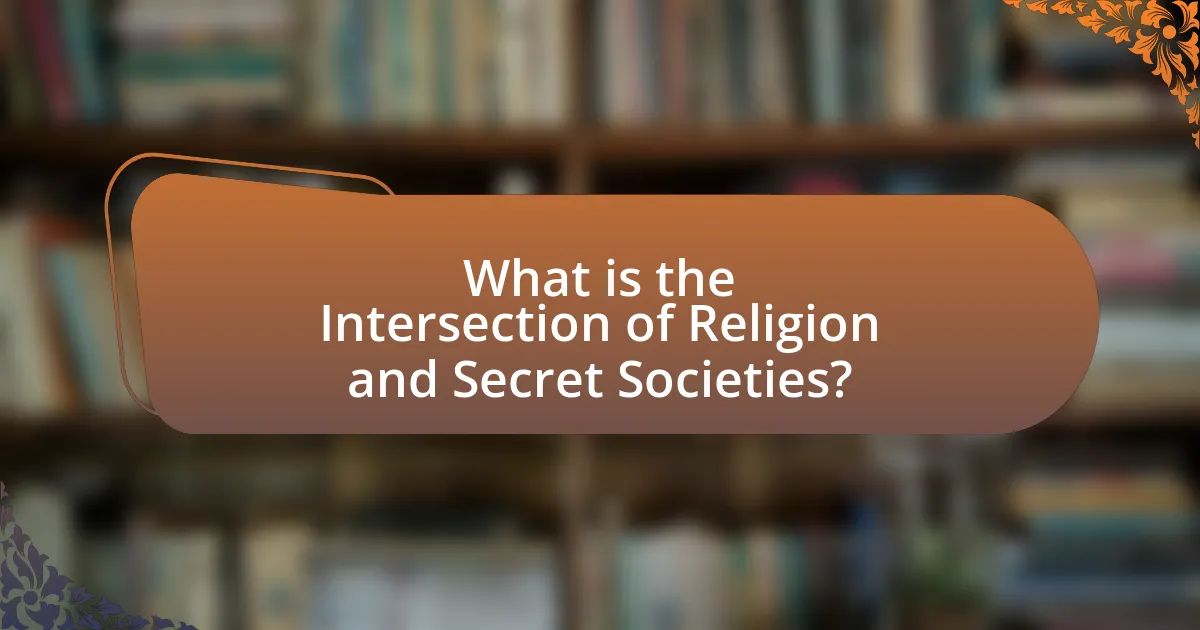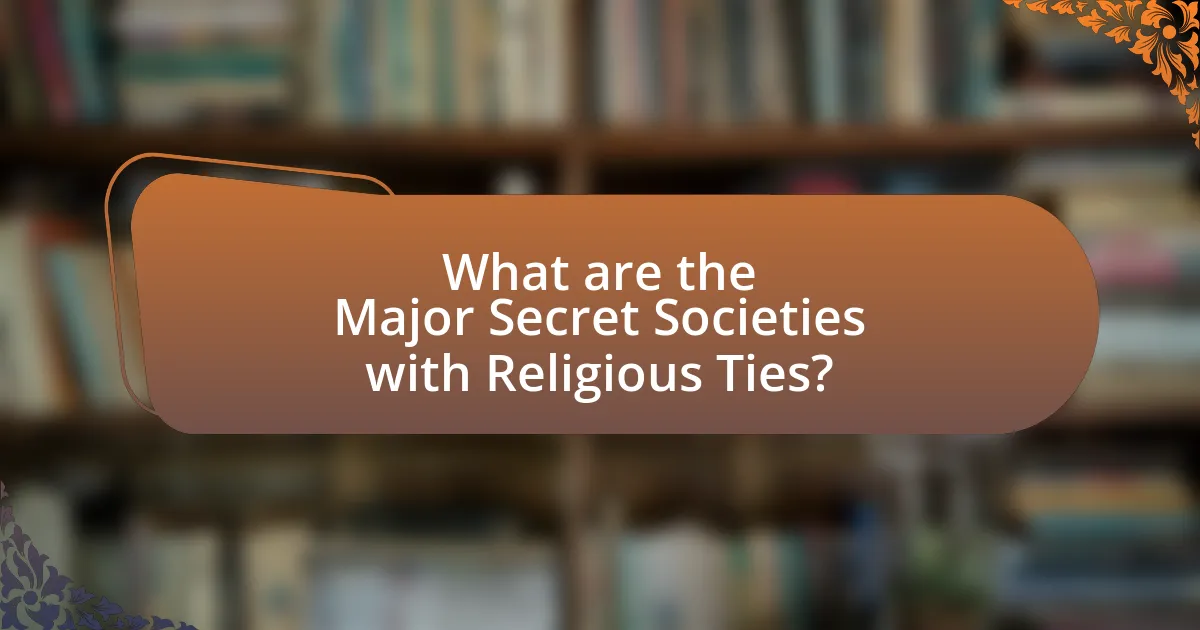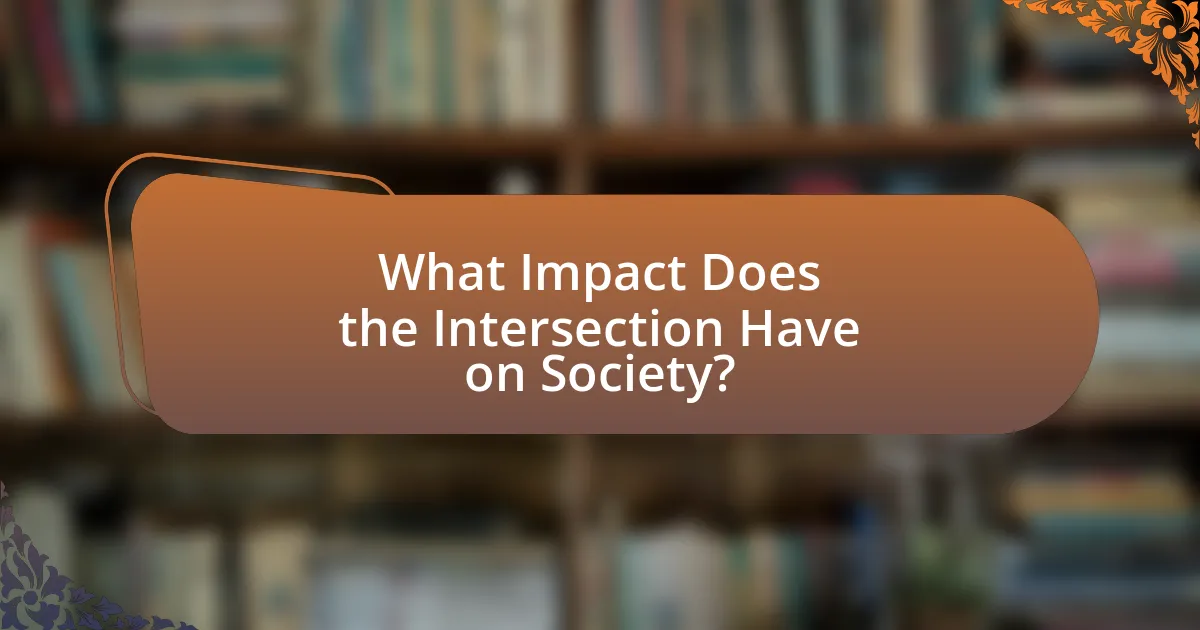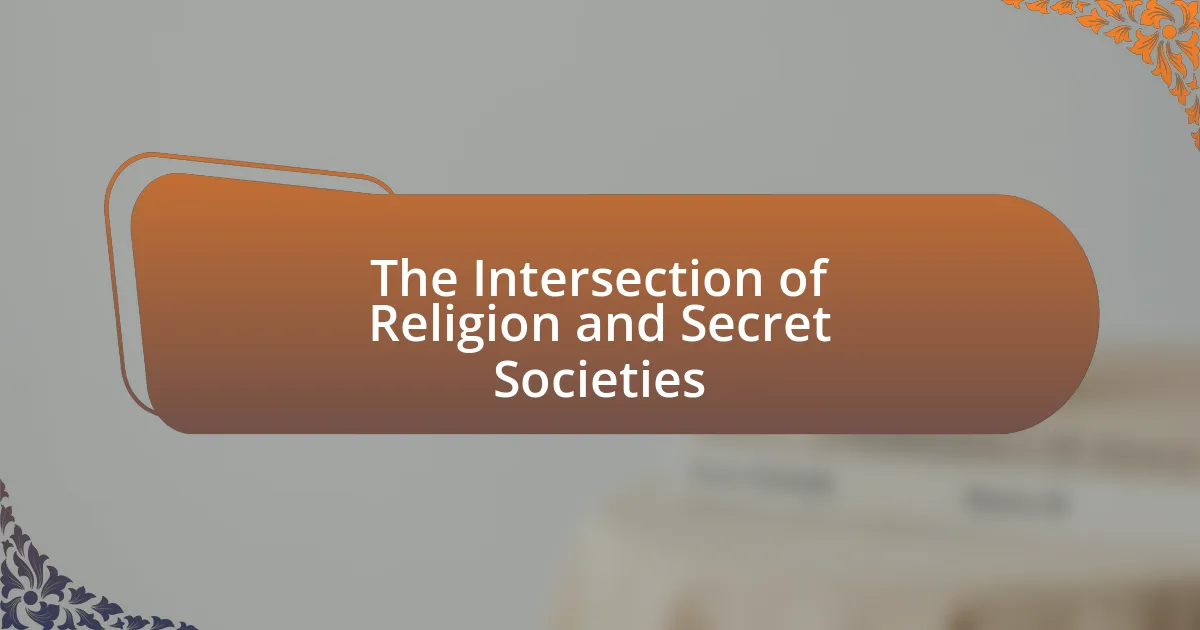The intersection of religion and secret societies explores the integration of spiritual beliefs with clandestine organizations that often operate outside mainstream religious practices. This article examines how secret societies, such as the Freemasons and Rosicrucians, incorporate religious symbols and rituals, influencing their structures and philosophies. It highlights the mutual influence between these entities, historical examples illustrating their relationship, and the ethical dilemmas that arise from their secrecy. Additionally, the article discusses the impact of this intersection on societal norms, political structures, and individual beliefs, providing insights into the complexities of faith and secrecy.

What is the Intersection of Religion and Secret Societies?
The intersection of religion and secret societies involves the blending of spiritual beliefs with clandestine organizations that often operate outside mainstream religious practices. Historically, many secret societies, such as the Freemasons and the Rosicrucians, have incorporated religious symbols, rituals, and philosophies into their frameworks, drawing on various religious traditions to create a unique spiritual experience. For example, Freemasonry utilizes allegorical teachings derived from biblical texts, emphasizing moral and ethical development through a structured initiation process. This relationship highlights how secret societies can serve as alternative spiritual communities, offering members a sense of belonging and deeper esoteric knowledge that may not be accessible within conventional religious institutions.
How do religion and secret societies influence each other?
Religion and secret societies influence each other through shared rituals, beliefs, and the pursuit of esoteric knowledge. Many secret societies, such as the Freemasons, incorporate religious symbols and themes into their practices, reflecting the influence of religious traditions. Conversely, some religious groups have adopted secretive practices to protect their beliefs from persecution, as seen in early Christianity, where followers often met in secret to avoid Roman authorities. This interplay demonstrates how both entities can shape each other’s ideologies and practices, creating a complex relationship that has evolved over time.
What historical examples illustrate this influence?
The influence of religion on secret societies is illustrated by the Freemasons and the Rosicrucians. The Freemasons, originating in the late 16th to early 17th century, incorporated Christian symbolism and moral teachings into their rituals, reflecting the influence of Enlightenment thought and religious ideals. The Rosicrucians, emerging in the early 17th century, blended Christian mysticism with esoteric knowledge, promoting a spiritual transformation that aligned with their secretive practices. Both groups demonstrate how religious beliefs shaped their structures, rituals, and philosophies, influencing broader societal views on spirituality and knowledge.
How do beliefs and rituals in religion shape secret societies?
Beliefs and rituals in religion significantly shape secret societies by providing a framework for their values, practices, and organizational structures. Religious beliefs often serve as the foundational ideology that justifies the existence and activities of secret societies, creating a sense of purpose and identity among members. For instance, many secret societies incorporate religious symbols, texts, and rituals into their ceremonies, which reinforces their commitment to shared beliefs and fosters a sense of belonging.
Historically, organizations like the Freemasons have utilized elements from various religious traditions, such as the use of allegorical teachings and moral lessons derived from religious texts, to cultivate a sense of enlightenment and ethical conduct among members. This blending of religious elements not only legitimizes the society’s objectives but also enhances the secrecy and exclusivity that characterize such groups, as members engage in rituals that are often shrouded in esoteric meanings.
Moreover, the communal aspect of religious rituals strengthens the bonds between members, creating a network of loyalty and mutual support that is essential for the functioning of secret societies. This dynamic illustrates how deeply intertwined religious beliefs and rituals are with the formation and operation of secret societies, shaping their identity and practices throughout history.
Why do secret societies often incorporate religious elements?
Secret societies often incorporate religious elements to create a sense of shared belief and purpose among members. This incorporation fosters a strong bond and commitment, as rituals and symbols derived from religious traditions can enhance the group’s identity and cohesion. For instance, many secret societies, such as the Freemasons, utilize allegorical teachings and symbols that draw from various religious texts, which serve to convey moral lessons and promote ethical behavior among members. Historical evidence shows that these societies often emerged in contexts where religious authority was significant, thus intertwining their practices with spiritual beliefs to legitimize their existence and attract followers.
What role does symbolism play in these societies?
Symbolism serves as a crucial mechanism for communication and identity within societies, particularly in the context of religion and secret societies. It allows members to convey complex ideas, beliefs, and values through visual and auditory symbols, such as rituals, emblems, and gestures. For instance, in Freemasonry, symbols like the square and compass represent moral and ethical guidelines, facilitating a shared understanding among members. This use of symbolism fosters a sense of belonging and reinforces group cohesion, as members interpret and internalize these symbols in ways that align with their collective identity and spiritual beliefs.
How do initiations reflect religious practices?
Initiations reflect religious practices by serving as formal rites of passage that signify an individual’s entry into a spiritual community or tradition. These ceremonies often involve specific rituals, symbols, and teachings that embody the core beliefs and values of the religion. For example, in many indigenous cultures, initiation rituals may include tests of endurance or knowledge that align with the community’s spiritual worldview, reinforcing the importance of cultural identity and continuity. Additionally, in Christianity, baptism serves as an initiation that symbolizes purification and acceptance into the faith, illustrating how such practices are integral to the religious experience and community cohesion.
What are the common themes found at the intersection of these two entities?
Common themes at the intersection of religion and secret societies include the pursuit of esoteric knowledge, the use of rituals and symbols, and the influence of belief systems on social structures. Both entities often emphasize the importance of initiation and membership, suggesting that deeper truths are accessible only to a select few. Historical examples, such as the Freemasons and their connections to various religious traditions, illustrate how secret societies can adopt and adapt religious symbols and practices to create a unique identity. Additionally, the tension between secrecy and transparency often reflects broader societal debates about authority and control within religious contexts.
How do power dynamics manifest in religious secret societies?
Power dynamics in religious secret societies manifest through hierarchical structures, exclusive membership, and the control of knowledge. These societies often establish a clear chain of command, where leaders wield significant influence over members, dictating beliefs and practices. For instance, the Freemasons operate with a tiered system of degrees, where higher-ranking members possess greater authority and access to esoteric teachings, reinforcing their power. Additionally, the secrecy surrounding rituals and doctrines creates an environment where knowledge is a form of control, allowing leaders to maintain dominance over followers. Historical examples, such as the Rosicrucians in the 17th century, illustrate how these dynamics can shape social interactions and influence broader societal norms.
What ethical dilemmas arise from the combination of religion and secrecy?
The combination of religion and secrecy creates ethical dilemmas such as the potential for manipulation, exclusion, and the erosion of trust. Manipulation occurs when religious leaders exploit secrecy to control followers, as seen in various cults where hidden teachings are used to maintain power. Exclusion arises when secretive religious practices create divisions between insiders and outsiders, leading to discrimination against those not privy to the information. The erosion of trust can manifest when religious organizations prioritize secrecy over transparency, undermining the moral authority they claim to uphold. These dilemmas highlight the complex interplay between faith, power, and ethical responsibility in secretive religious contexts.

What are the Major Secret Societies with Religious Ties?
The major secret societies with religious ties include the Freemasons, the Rosicrucians, and the Knights Templar. The Freemasons, originating in the late 16th to early 17th century, incorporate various religious symbols and rituals, emphasizing moral and ethical teachings. The Rosicrucians, founded in the early 17th century, blend mysticism and esoteric knowledge with Christian themes, promoting spiritual enlightenment. The Knights Templar, established in the 12th century, were originally a military order with strong connections to the Catholic Church, and they are often associated with various legends and myths regarding hidden knowledge and treasures. Each of these societies has played a significant role in intertwining religious beliefs with their secretive practices and organizational structures.
Which secret societies are most commonly associated with religion?
The secret societies most commonly associated with religion include the Freemasons, the Rosicrucians, and the Knights Templar. The Freemasons, founded in the late 16th to early 17th century, incorporate various religious symbols and rituals, emphasizing moral and ethical teachings derived from multiple faiths. The Rosicrucians, originating in the early 17th century, blend esoteric Christian mysticism with alchemical and philosophical ideas, promoting spiritual enlightenment. The Knights Templar, established in the 12th century, were originally a Christian military order that became entwined with various religious myths and legends, particularly regarding the Holy Grail and sacred relics. These societies have historically intertwined their practices and beliefs with religious themes, influencing both spiritual and secular realms.
What are the origins of the Freemasons in relation to religion?
The origins of the Freemasons in relation to religion can be traced back to the late 16th and early 17th centuries, primarily in Europe. Freemasonry emerged from the guilds of stonemasons and cathedral builders, which incorporated religious symbolism and moral teachings derived from various religious traditions, particularly Christianity. The rituals and symbols used in Freemasonry often reflect biblical references, emphasizing moral values and ethical conduct. Historical documents, such as the “Regius Manuscript” from around 1390, indicate that early Masonic lodges included religious elements in their practices, highlighting the intertwining of craft and faith.
How does the Rosicrucian Order blend mysticism and religion?
The Rosicrucian Order blends mysticism and religion by integrating esoteric spiritual teachings with elements of various religious traditions. This synthesis is evident in their emphasis on personal spiritual enlightenment, which draws from mystical practices such as meditation and alchemy, while also incorporating religious symbols and texts from Christianity, Kabbalah, and other faiths. Historical documents, such as the Rosicrucian manifestos from the early 17th century, illustrate this blend by promoting a universal spiritual philosophy that transcends individual religions, advocating for a deeper understanding of the divine through mystical experience.
What are the beliefs and practices of these societies?
The beliefs and practices of secret societies often revolve around esoteric knowledge, rituals, and a shared sense of purpose among members. These societies typically emphasize secrecy, initiation rites, and the transmission of hidden truths, which can be linked to broader religious or spiritual frameworks. For example, the Freemasons incorporate moral teachings and allegorical lessons derived from various religious traditions, while the Rosicrucians focus on mystical insights and personal enlightenment. Historical evidence shows that many secret societies, such as the Illuminati, were founded on Enlightenment principles, advocating for reason and individualism, which often conflicted with established religious doctrines. This intersection highlights how secret societies can serve as alternative spiritual paths, providing members with a sense of community and belonging outside mainstream religious institutions.
How do rituals in these societies reflect their religious affiliations?
Rituals in societies often serve as direct expressions of their religious affiliations by embodying the beliefs, values, and practices central to those faiths. For instance, in many indigenous cultures, rituals such as ceremonies, dances, and offerings are performed to honor deities and ancestors, reflecting a deep connection to their spiritual beliefs. These practices are often rooted in historical traditions that align with specific religious doctrines, such as the use of sacred symbols or the recitation of prayers that are unique to that faith.
Moreover, anthropological studies, such as those by Victor Turner, illustrate how rituals function as a means of social cohesion and identity, reinforcing the community’s shared religious values. In secret societies, rituals may also include initiation ceremonies that signify a member’s commitment to the group’s religious beliefs, further highlighting the intersection of ritual practice and religious affiliation.
What are the membership requirements and oaths taken?
Membership requirements for secret societies often include a commitment to secrecy, a specific belief system, and sometimes a recommendation from current members. For example, many societies require candidates to demonstrate loyalty and integrity, as well as an understanding of the society’s values and rituals.
Oaths taken by members typically involve pledges of secrecy and fidelity to the organization, often accompanied by symbolic rituals that reinforce the commitment. These oaths serve to bind members to the society’s principles and to each other, ensuring that the knowledge and practices of the group remain confidential.
How do these societies maintain secrecy while promoting religious ideals?
Secret societies maintain secrecy while promoting religious ideals through structured rituals and selective membership. These societies often employ initiation processes that require members to undergo specific rites, which not only reinforce their commitment to the group’s beliefs but also create a barrier to entry for outsiders. For example, the Freemasons utilize a series of degrees that members must progress through, each involving confidential knowledge and symbols that are only revealed to those who have proven their loyalty. This method of controlled information dissemination ensures that the core religious tenets are preserved within the group while remaining hidden from the public. Additionally, the use of coded language and symbols further protects their teachings, allowing members to communicate their beliefs without exposing them to external scrutiny. Historical instances, such as the Knights Templar, illustrate how secrecy can be intertwined with religious devotion, as their clandestine practices were often justified by their commitment to a higher spiritual cause.
What methods do they use to protect their teachings?
Secret societies often use methods such as oral transmission, coded language, and ritualistic practices to protect their teachings. Oral transmission ensures that knowledge is passed down through trusted members, minimizing the risk of exposure to outsiders. Coded language creates a barrier to understanding for those not initiated, while ritualistic practices serve to reinforce the secrecy and significance of the teachings among members. These methods have historical precedence, as seen in organizations like the Freemasons, who have utilized similar techniques to safeguard their esoteric knowledge from public scrutiny.
How do they balance public perception with private beliefs?
Individuals involved in secret societies often balance public perception with private beliefs by maintaining a dual identity. They publicly align with societal norms and expectations while privately adhering to the values and teachings of their secret affiliations. This balancing act is crucial for preserving their social standing and avoiding backlash, as seen in historical examples where members of secret societies, like the Freemasons, publicly engaged in community service while privately practicing their rituals. Such strategies allow them to navigate potential conflicts between their public personas and private convictions effectively.

What Impact Does the Intersection Have on Society?
The intersection of religion and secret societies significantly influences societal structures and cultural norms. This impact manifests through the shaping of belief systems, social cohesion, and power dynamics within communities. For instance, secret societies often utilize religious symbolism and rituals to foster a sense of belonging among members, which can reinforce group identity and solidarity. Historical examples include the Freemasons, who incorporated religious elements into their practices, thereby affecting societal perceptions of morality and ethics. Additionally, the interplay between these entities can lead to both conflict and collaboration, as seen in various historical contexts where religious groups have either opposed or allied with secret societies to achieve common goals. This dynamic ultimately contributes to the broader discourse on authority, governance, and social order within society.
How does the intersection of religion and secret societies affect cultural norms?
The intersection of religion and secret societies significantly influences cultural norms by shaping belief systems and social behaviors. Secret societies often incorporate religious symbols, rituals, and ideologies, which can reinforce or challenge existing cultural values. For instance, the Freemasons, a well-known secret society, integrate elements of various religious traditions into their practices, promoting values such as brotherhood and charity, which can alter societal expectations around community support and moral conduct. Historical examples, such as the role of the Rosicrucians in the 17th century, illustrate how secret societies can introduce new philosophical ideas that challenge mainstream religious doctrines, thereby shifting cultural paradigms. This dynamic interaction can lead to the emergence of new cultural norms that reflect a blend of religious and secretive influences.
What influence do these societies have on political structures?
Secret societies significantly influence political structures by shaping ideologies, facilitating networking among elites, and impacting decision-making processes. For instance, organizations like the Freemasons have historically included influential political figures, which allowed them to promote specific values and agendas within governance. The involvement of such societies in political affairs can be seen in the establishment of democratic principles during the Enlightenment, where Masonic ideals contributed to revolutionary movements in America and France. Additionally, the secrecy and exclusivity of these societies often lead to the formation of informal power dynamics that can bypass traditional political channels, thereby altering the landscape of governance and policy-making.
How do they shape social movements and ideologies?
Religion and secret societies shape social movements and ideologies by providing frameworks for collective identity and action. These entities often mobilize individuals around shared beliefs and values, fostering a sense of belonging that can drive social change. For instance, the Freemasons have historically influenced political movements by promoting Enlightenment ideals such as liberty and equality, which contributed to revolutions like the American Revolution. Similarly, religious groups, such as the Civil Rights Movement led by figures like Martin Luther King Jr., utilized religious rhetoric to advocate for social justice, demonstrating how these organizations can galvanize support and legitimize social causes.
What controversies arise from the intersection of these two entities?
The intersection of religion and secret societies often leads to controversies surrounding beliefs, practices, and power dynamics. For instance, secret societies like the Freemasons have faced criticism from various religious groups, particularly the Catholic Church, which has historically condemned their practices as incompatible with Christian teachings. This condemnation is evidenced by the papal encyclicals, such as “Humanum Genus” issued by Pope Leo XIII in 1884, which explicitly denounced Freemasonry for its perceived anti-religious stance and secretive nature. Additionally, the blending of esoteric religious beliefs within secret societies can provoke debates about authenticity and orthodoxy, as seen in the tensions between mainstream religious institutions and groups that adopt mystical or occult practices. These controversies highlight the ongoing struggle over authority, interpretation, and the role of secrecy in spiritual matters.
How do conspiracy theories relate to secret societies and religion?
Conspiracy theories often link secret societies and religion by suggesting that these societies manipulate religious beliefs for control or influence. For instance, many conspiracy theories posit that organizations like the Freemasons or the Illuminati operate behind the scenes to shape religious narratives and societal norms, thereby exerting power over followers. Historical examples include the perception that the Catholic Church has concealed truths or that certain religious texts have been altered to serve the interests of powerful groups. These theories thrive on the secrecy associated with such societies, leading to a belief that hidden agendas are at play within religious institutions.
What are the implications for religious institutions?
The implications for religious institutions include potential challenges to their authority and influence, as secret societies often operate outside traditional religious frameworks. This can lead to a dilution of religious teachings and practices, as members may prioritize the values and rituals of secret societies over those of their faith. Additionally, the existence of secret societies can create tensions within religious communities, as members may struggle with conflicting loyalties. Historical examples, such as the Freemasons’ influence in the 18th century, demonstrate how secret societies can impact religious institutions by attracting followers away from mainstream beliefs, thereby altering the religious landscape.
What can individuals learn from the intersection of religion and secret societies?
Individuals can learn about the complex relationship between belief systems and power dynamics at the intersection of religion and secret societies. This intersection reveals how secret societies often utilize religious symbolism and rituals to create a sense of belonging and authority among members. Historical examples, such as the Freemasons, demonstrate that these societies frequently incorporate religious themes to establish moral frameworks and community bonds, while also serving as a means of social and political influence. Furthermore, the study of this intersection highlights the potential for both positive community building and negative manipulation, as seen in various historical contexts where secret societies have either supported or undermined religious institutions.
How can understanding this intersection enhance personal beliefs?
Understanding the intersection of religion and secret societies can enhance personal beliefs by providing deeper insights into the symbolic and ritualistic elements that shape spiritual experiences. This understanding reveals how secret societies often incorporate religious themes, which can lead individuals to re-evaluate their own beliefs and practices. For instance, historical examples such as the Freemasons, who integrate various religious symbols and philosophies, illustrate how these organizations can influence personal spirituality and ethical frameworks. By exploring these connections, individuals may find a more nuanced perspective on their faith, leading to a more enriched and informed belief system.
What best practices can be adopted for engaging with these topics thoughtfully?
Engaging thoughtfully with the intersection of religion and secret societies requires a commitment to open-mindedness and critical analysis. Practitioners should prioritize research from credible sources, such as academic journals and historical texts, to understand the complexities involved. For instance, examining the works of scholars like J. Gordon Melton, who has extensively studied new religious movements, can provide valuable insights. Additionally, fostering respectful dialogue with individuals from diverse backgrounds can enhance understanding and reduce biases. Engaging in discussions that emphasize empathy and active listening further promotes a thoughtful exploration of these intricate topics.
